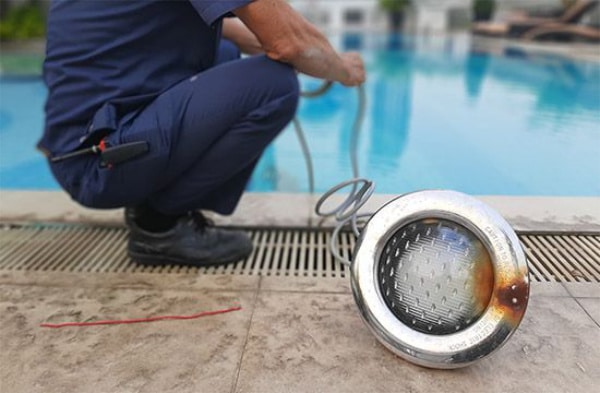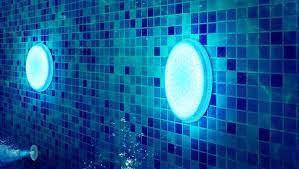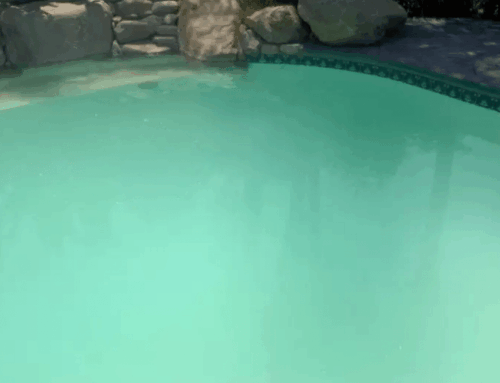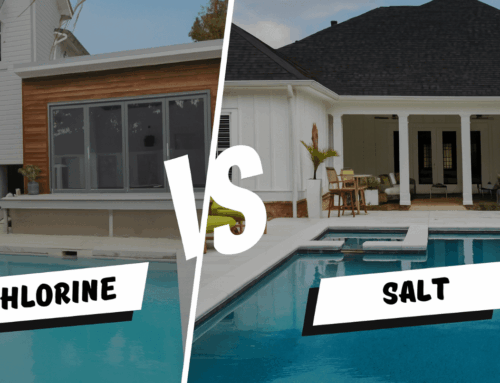
to replace a pool light first cut power at the breaker, verify the circuit is dead, lift the light onto a towel, replace the globe or sealed LED unit with a new gasket, then re seat and test. Never work on live circuits or cracked fixtures under water when you are working on swimming pool lights.
What types of pool lights are there
Pool lights come in three main families.
- Incandescent or halogen swimming pool lights: older tech, higher heat and power use, simple to relamp with a replacement bulb but gaskets often need changing.
- LED lights: cool running and energy efficient with long life. Many are sealed units that replace the entire light fixture.
- Colour changing LEDs: cycle via power toggling or a controller for programs and effects.
If you are comparing models, start with our Pool Light product page.
How long do pool lights typically last
Service life depends on technology, run time and sealing.
- Halogen or incandescent globes: usually 1 to 3 years. Heat and water ingress shorten life.
- Quality LED fixtures: typically 5 to 10 years for the light engine, longer when the gasket seals well and water chemistry is in range.
Is it safe to replace a pool light myself
Only if you can fully isolate power and confirm zero volts.
- Turn the circuit off at the breaker and test at the light cable with a multimeter or non contact tester.
- If the niche or conduit contains water, stop and book a licensed electrician. For hands-on help, see Pool Light Repair.

What tools do I need to replace a pool light
Assemble everything before you loosen a single screw.
- Insulated screwdriver that fits the retaining screw head.
- Multimeter or non contact tester to confirm power is off.
- Towel on the pool’s edge to protect lenses and tiles.
- New gasket and lubricant, or a complete sealed LED replacement.
- Small container for screws so nothing drops into the pool.
- Optional: silicone grease for the cord grommet and strain relief.
Do I have to drain the pool?
Usually not. Most wet niche lights have enough service cable to lift the body onto the deck without lowering the water level. Many surface mount and nicheless LED lights also service above the waterline. Keep parts on a towel and keep the lens out of direct sun.
How do I find the make and model of my existing pool light
Identify the unit before you order parts.
- Remove the face ring and look for a label on the back of the light body.
- Photograph the niche, face ring, screw holes, cord entry and any connector.
- Note the lens diameter and shape to match retrofit kits.
Can I switch from incandescent or halogen to LED in the same niche
In many cases, yes.
- Retrofit PAR56 and brand specific LED kits are designed to fit common niches.
- Replace the gasket, check the cord entry seal and confirm the strain relief is secure before reinstalling.
- Always match voltage and transformer rating to the new LED lights.
As examples, see LED ranges like EM Atom Series or Photon GK Series.

Why did my pool light stop working
Most failures come from heat, moisture or a tripped safety device.
- Blown globe or failed LED driver.
- Tripped RCD or GFCI at the board.
- Water in the light from a perished gasket. Look for condensation, corrosion and water inside the lens.
What does “niche” mean in pool lighting
The niche is the housing embedded in the pool wall.
It supports cooling, sealing and cable management. A correct fit keeps the light secure and helps the sealed unit shed heat into the pool water.
What wattage and voltage do pool lights use
Modern LEDs commonly run at 12 V from a transformer.
Legacy systems may be 120 V or 240 V depending on region. Always confirm light and transformer ratings before replacement and never mix voltages on the same circuit.
Common pool light sizes and how to identify them
PAR56 round lamps are widespread, but many brands are proprietary.
Measure the face ring diameter and check the model plate on the body. Photograph the mounting tabs and screws attaching the face ring so you order the correct kit.
Do LED pool lights save money
Yes. LED pool lights cut power use dramatically and reduce relamping. Lower heat also reduces gasket stress. Many models include colour programs without extra controllers. If you are upgrading from halogen, our team can match brightness and colour to your finish.
Safety steps before working on a pool light
Follow these checks every time.
- Turn off power at the breaker and lock out if possible.
- Verify zero voltage with a tester at the light cable.
- Work with dry hands on a towel and secure small parts.
- Never energise a cracked, flooded or unsealed unit.
Good maintenance habits reduce risks during cleaning and season checks. For a simple routine that keeps everything on track, see How Often Should a Pool Be Serviced?.
Step by step overview: replace a pool light
This is a high level replacement outline.
- Isolate and test. Switch off at the breaker, confirm dead with a meter.
- Remove the light. Undo the single retaining screw at the 12 o’clock position, then lift the body onto the deck. Some models unclip instead of using a single screw.
- Open the body. For halogen or incandescent, open the housing and remove the bulb. For sealed LED units, follow the brand procedure to separate the face ring.
- Replace parts. Fit the new globe or sealed LED module. Always install a new gasket lightly lubricated so it seats without twisting.
- Service the cord. Check the cord grommet and strain relief. Re seat the cable so it is not pinched and has slack to reach the surface next time.
- Test above water. Briefly energise out of the water to confirm the light works, then switch off. Do not run halogen lamps dry for long.
- Re mount and final test. Refit the light into the niche, align tabs, tighten the retaining screw and test again. Ensure screws are snug, not over tight.
Colour changing and controls
Match the control method to your power supply.
Some LEDs change colour by cycling power off and on. Others connect to a controller for preset programs. Confirm compatibility with your transformer and any automation.
When to call a professional
Stop and call a licensed electrician if you find any of the following.
- Water inside the conduit or niche.
- Damaged insulation or corroded terminals.
- Wrong transformer voltage or unclear earthing and bonding.
- RCD trips that persist after replacement.
- Uncertain wiring or no service loop to safely reach the pool’s edge.
If you prefer a done-for-you replacement or an LED upgrade, book Pool Light Repair or reach out via Contact Us.
Conclusion
A safe, lasting pool light replacement is mostly about isolation, sealing and the right parts. Confirm power is off, fit a fresh gasket, match voltage, and test above water before you remount. If you are choosing a new LED, compare options in our Pool Lights , or ask our technicians on Pool Light Repair to supply and install a matched unit. Ready to book or have questions about your niche and transformer? Contact us and we will guide you step by step.

With over 20 years of industry experience, Adrian Mole is the founder of 1 Pool Care, a leading mobile pool service in Perth. Known for his expert knowledge and reliable service, Adrian delivers professional pool cleaning, equipment repairs, and water balancing across the metro area. Backed by SPASA accreditation, he’s committed to quality, convenience, and customer satisfaction.










Social Media